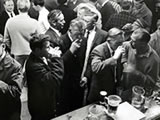What happened that day?
See historic events for any day of the year by entering the date below. Why not try your birthday?
Kiwi of the Week
Today in History

1967 The end of the 'six o'clock swill'
Six p.m. closing for pubs was introduced as a 'temporary' wartime measure in December 1917. It was made permanent the following year, ushering in what became know as the 'six o'clock swill', as patrons aimed to get their fill before closing time.
Since the 1880s the campaign for the prohibition of the sale of alcohol had developed into a powerful mass movement. Its supporters promoted sobriety as a ‘patriotic duty’ during wartime, and in 1915 and 1916 nearly 160,000 New Zealanders signed petitions calling for six o’clock closing. The government agreed to restrict opening hours in order to increase efficiency in the wartime workforce.
In 1918, when the new hours became permanent, the liquor trade offered little resistance. The previous year's measure had ‘drawn some of the sting out of the wider Prohibition movement’ and was preferable to a total ban. In a special referendum held in April 1919 and again at the general election in December 1919 prohibition was only narrowly defeated. The cause continued to enjoy strong support at the polls throughout the 1920s.
Six o’clock closing became a part of the New Zealand way of life. In the short period between the end of the working day and closing time at the pub, large numbers of men crowded together to drink as much beer as they could before the so-called ‘supping-up’ time of 15 minutes was announced.
The measure was decisively endorsed in a referendum in 1949. By then, pub owners were concerned that later opening hours could create difficulties for the trade ‘in the matter of overtime pay and other costs’.
A mood for change began to emerge in the 1960s. The growing restaurant industry questioned laws that made it difficult to sell alcohol with meals. People socialising at the local sports club or RSA also sought a change to opening hours. As the number of tourists to New Zealand increased following the arrival of jet air travel, six o’clock closing was increasingly seen as an outdated concept. In 1966 the Licensing Control Commission stated that a uniform law for hours of sale in all places was ‘neither equitable, enforceable, nor in the public interest’.
When a second national referendum was held in late September 1967, nearly 64% of voters supported a return to ten o’clock closing. The government wasted little time in acknowledging the result and the new hours were introduced on 9 October.
Six o’clock closing has been seen by many commentators as teaching two generations of Kiwi men to drink as fast as possible, contributing to a binge-drinking culture. While early closing was promoted as a way of ensuring that men got home to their families at a respectable hour, critics questioned the condition that most men returned in.
Image: Porirua Tavern, 1967
Internal links
Food in 20th century New ZealandLife in New Zealand - assisted immigrationVoting for prohibition1967 - key events














